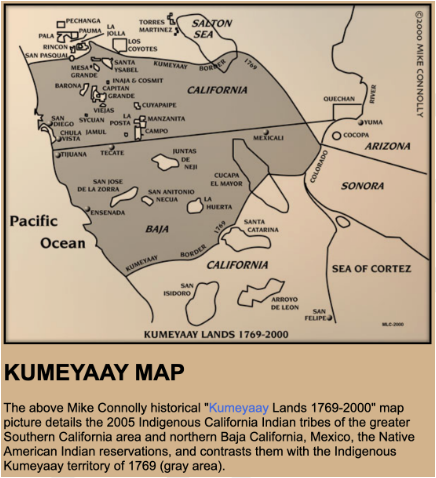Source: http://www.kumeyaay.info/kumeyaay_maps/kumeyaay_map.html
We recognize that San Diego Miramar College sits on the ancestral homeland of the Kumeyaay, Luiseño, Cupeño, and Cahuilla tribes, who have lived in this area for well over 10,000 years, and we honor their past, present, and future connection to this land and its inherent connection to their identity.
We acknowledge our occupation of unceded Kumeyaay land and the violent systemic injustices this has continuously perpetuated for Native peoples of this region. We pay respect to the Indigenous people of San Diego County - past, present, and future - and honor their continuing presence in their homeland and their spiritual beliefs that land does not belong to people; people belong to land.
We also acknowledge that this is merely the beginning, and there is far more work to be done in an attempt to heal all of the injustices and inequities that still exist today and throughout their entire historical diaspora. We commit to moving forward together.
At San Diego Miramar College, a land acknowledgment is one step toward equity for our Native-identified students. Our larger goal is to develop effective and equitable pathways for Native students; increase enrollment, persistence, and success; and create a welcoming environment on campus that cares for the whole student. We have been working towards these goals through a series of collaborations between the IDEA (Inclusion, Diversity, Equity, and Anti-Racism) Committee, Land Acknowledgement Task Force, and the Native and Indigenous Issues Community of Inquiry over the past several years and will continue this work into the future. Acknowledging our relationship to the land that our college and district occupies is an important step in recognizing our role as settlers; however, it is the first step on a longer journey.
Please take some time to watch the following video linked here (time stamp1:45 - 2:02) to learn of the proper pronunciation of the Kumeyaay, Luiseño, Cupeño, and Cahuilla tribes.
Making a land acknowledgment meaningful
Miramar College is committed to an action plan supporting its land acknowledgment. We recognize that without action, any acknowledgment is simply performative. Therefore, our college has taken the steps below as part of its action plan and will continue to engage in this work by pursuing additional goals.
To support our land acknowledgment, Miramar College has
- Developed an interactive self-study module, Land Acknowledgement: Invitation to Begin, which is available on our LEAD pages of the Miramar College website. This module invites members of our campus community to engage with the reasons behind the land acknowledgment and connect with the statement in a personal way.
- Initiated a new subject indicator, NAIS, creating a program in Native American and Indigenous Studies. The new subject indicator has been approved by the SDCCD District Curriculum and Instructional Council (CIC). With this new program, we will be able to offer courses in Native American Studies.
- Completed a Needs Assessment survey for our Native-identified students (FA2022).
- Identified scholarships for Native students which are now listed on the Miramar student scholarship web page.
- Identified an advisor for a Native/Indigenous/First Nations Student Club.
- Hosted campus speakers:
- Dr. Laurie Egan-Hedley, Director, Barona Cultural Center and Museum - SP21
- Dr. Deondre Smiles (Leech Lake Band of Ojibwe), University of Victoria - FA21
- Dr. Manulani Aluli Meyer (Native Hawaiian), University of Hawaii, West Oahu - Keynote speaker for Flex Week, SP22
What do we know about the history of this area?
San Diego Miramar College stands on unratified treaty lands that belong to the Kumeyaay Nation. Although the exact history has been largely erased, we know that in 1769, Spanish colonizers settled near the Kumeyaay village of Kosa'aay (where Old Town sits today) and established the region's first Catholic Mission, the Mission San Diego de Alcalá.
For six years, the people of Kosa'aay resisted the occupation of their land by settlers and violence towards their people, including sexual violence toward women. In 1775, Kumeyaay villagers burnt down the Mission in protest. Across the Kumeyaay Nation, the people also defended their land from invasion from Mexico. After the Mexican American War (1846-1848), an arbitrary political border was drawn, splitting the Kumeyaay Nation in half. The California Gold Rush of 1848 exacerbated violent conflicts over land rights, with the United States committing acts of genocide in order to open tracts of California's land to settlers.
The Treaty of Santa Isabel (1852) was intended to ensure that the Kumeyaay and 17 other Indigenous Nations of California would remain sovereign nations within the United States. However, due to opposition from California settlers, this treaty was never ratified, and the land remains legally unceded from the Kumeyaay Nation to the U.S. (Campo History, Campo-nsn.gov).
How can I learn more?
The Miramar College's Land Acknowledgment task force is a subgroup of the IDEA (Inclusion, Diversity, Equity, and Anti-Racism) Committee. The task force is dedicated to pursuing campus goals that Indigenize our practices, support our Native-identified students, and address the decolonization of our processes and curricula. To join us or find out more, please contact the IDEA Committee.
From Fall 2021 through Spring 2022, Miramar Professional Development hosted a campus-wide Land Acknowledgment Community of Inquiry. Over two semesters, a group of campus faculty, Classified Professionals, Supervisors, and Administrators engaged in learning about historical and current challenges and resilience of Native communities, focusing on the Kumeyaay. This group produced the Land Acknowledgement: Invitation to Begin, an interactive self-study module for anyone interested in these topics.
We would like to gratefully acknowledge everyone for their guidance and feedback as we continue the work to support our land acknowledgment and our Native-identified students.
